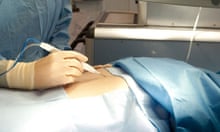Scientists have made pieces of human liver from stem cells and, by transplanting them into mice, have shown they behave like healthy organs.
Tiny clumps of liver tissue were hooked up to the animals' blood supplies soon after the operations. They took on the normal jobs of the liver, such as clearing toxins from the blood.
The work marks a world first for the field of regenerative medicine, which has promised so much but until now failed to produce the major achievement of a complex organ that connects to a recipient's blood supply.
The feat has bolstered hopes that stem cells will lead to revolutionary therapies that are less dependent on donors, by repairing or replacing damaged organs with tissue grown fresh in the laboratory.
If the procedure were proved to be safe, the transplants could replace 30% of normal liver function in an adult, the Japanese team said. That would transform the treatment of many patients with liver failure, though it may not be ready for clinics for another 10 years, the scientists said.
To create the human liver tissue, researchers at Yokohama City University took some human skin cells that had been chemically reprogrammed into an earlier stage of development. These cells (induced pluripotent stem cells) were treated to make them grow into early-stage liver cells.
The liver is made up of several kinds of cells, all of which do different jobs, such as providing structure and blood vessels for the organ. To mirror this, the scientists mixed the liver cells with two other sorts of human cells, including some from the veins of umbilical cords. To the scientists' surprise, the cells arranged themselves into a ball as they grew, mimicking the earliest stages of liver growth in a human embryo.
The clumps of cells grew rapidly for two months, at which stage they measured around five millimetres across. These "liver buds" were then transplanted under the skin of mice to see how they behaved. Images taken by the scientists show that over time the pieces of liver connected up to blood vessels in the animals. Once this happened, the tissue matured into what looked like adult liver.
To check how well the liver tissue worked, the scientists gave the mice two different drugs – an anti-inflammatory called ketoprofen, and a drug for high blood pressure called debrisoquine. When they tested the animals' blood, they found breakdown products that are normally made by the human liver and not by the mouse liver. "To our knowledge, this is the first report demonstrating the generation of a functional human organ from pluripotent stem cells," the authors wrote in the journal Nature.
In a second experiment, the scientists looked at whether the implanted liver tissue could help mice survive liver failure. One group of mice was implanted with 12 human liver buds each, and a second group was a control.
Both groups were given injections of diphtheria toxin through a vein in their tails. All of the control mice died within 10 days, but nearly a third of the treated mice survived for more than 40 days.
Dr Takanori Takebe said the team's next step was to make a large quantity of liver buds for testing in humans. Rather than replacing a diseased liver, the lab-grown liver tissue would sit nearby in the abdomen and provide a supportive role.
The liver tissue made so far used human cells from a number of different people, and any patient who received a transplant would need to take drugs to prevent rejection, as with any other organ transplant. As technology advances, though, it may become possible to make liver tissue from a patient's own cells, which would not be rejected.
Professor Anthony Warrens, president of the British Transplantation Society, said: "Advances in stem cell technology are tremendously exciting but remain many years from clinical application. For the foreseeable future the only feasible way to solve the problem of three people dying every day in the UK waiting for a transplant is to increase the number of organ donors."









